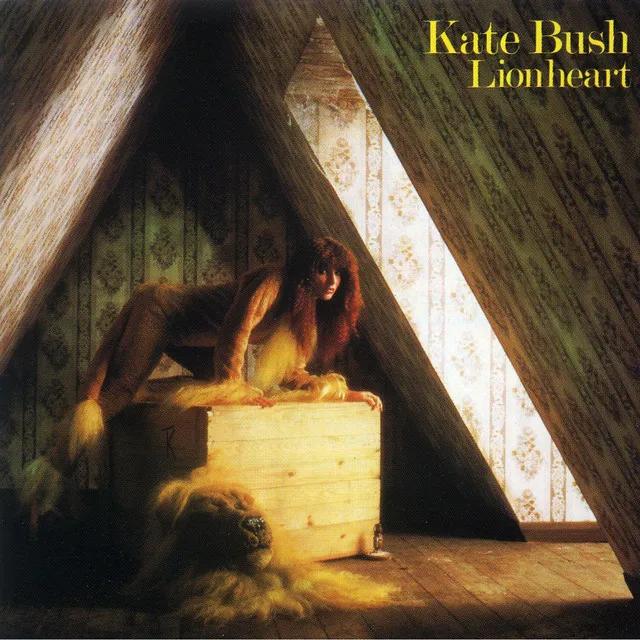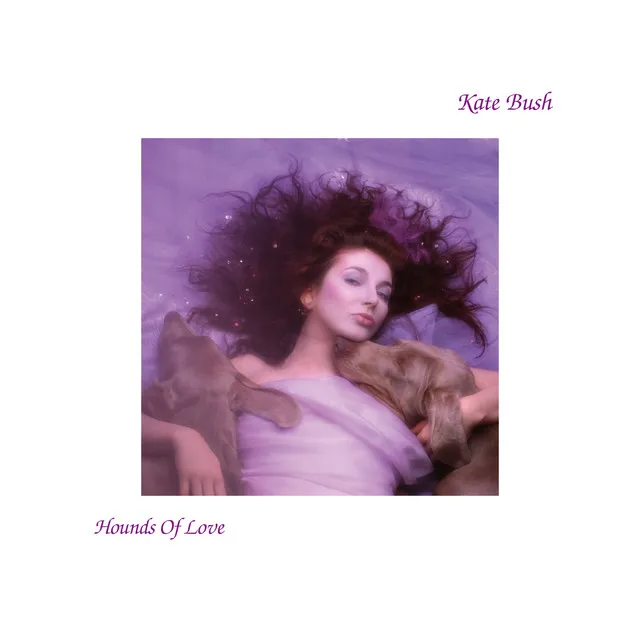Throughout the entirety of a one-of-a-kind creative journey, Kate Bush has achieved the rare feat of making innovative, fearlessly experimental work that's also wildly successful. From the start, Bush's music was ambitious and strange, and her mélange of art rock, pop hooks, theatrical twists, fantastical vocal performances, and complex musicianship resulted in hits. She became an immediate star in the U.K. in 1978 with the release of her debut single, "Wuthering Heights," and the subsequent album The Kick Inside, when she was just 19. While the crystal-clear high notes and lush instrumentation of "Wuthering Heights" set the scene for her star to rise, Bush expanded her vision rapidly with the subsequent self-produced albums The Dreaming (1982) and Hounds of Love (1985), both of which saw her embracing rudimentary electronic music production along with more personal lyrical themes and an unflinching commitment to conceptual presentation that put her at high risk for commercial failure. Quite the opposite played out, however, as these visionary albums broke through worldwide. Always working at a deliberate pace, Bush took a hiatus between 1993's The Red Shoes and 2005's Aerial, and from there sporadically released new material like 2011's 50 Words for Snow. The impact of Bush's music, aesthetic, and approach to art cannot be overstated. Along with the impression her sound made on peers like Peter Gabriel, Eurythmics, Erasure, Prince, and others, echoes of Bush's reality-bending vocal style and imaginative sound sculpting have appeared perennially in every generation of new artists that followed her. While a direct resemblance can be heard to stars like Tori Amos, Björk, Antony and the Johnsons, or FKA Twigs, the totality of her influence is much deeper, with everyone from John Lydon to Grimes to OutKast's Big Boi citing Bush as a guiding force for their music.
Kate Bush was born Catherine Bush in 1958. She studied piano and violin while attending the St. Joseph's Convent Grammar School in Abbey Wood in South London. By the time she was a teenager, she was writing songs of her own. A family friend brought her to the attention of Pink Floyd lead guitarist David Gilmour, who arranged for the 15-year-old to record her first demo. With Gilmour's help, Bush was signed to EMI Records at age 16, though the company made the decision to break her in slowly. She studied dance, mime, and voice, and continued writing. She also began thinking in terms of which of the 200 or so songs she'd written would be on her first recording, and by 1977, she was ready to begin her formal career, which she did with an original song, "Wuthering Heights," based on material from Emily Bronte's novel (and more directly inspired by Bush's seeing the 1970 film directed by Robert Fuest and starring Timothy Dalton and Anna Caulder Marshall).
"Wuthering Heights" hit number one on the British charts when it was released in 1978, and Bush immediately arrived. Her debut album, The Kick Inside, a collection of material that she had written from the age of 15 and onward -- some of it displaying extremely provocative and sophisticated sexual references and images -- reached number three and sold over a million copies in the U.K.
Bush's second album, Lionheart, reached number six but didn't achieve anything like the sales totals or critical acclaim of its predecessor, and in later years, Bush regretted the rush in planning and recording that album to capitalize on the success of her debut. In England during the spring of 1979, she embarked on what proved to be the only concert tour of the first 37 years of her career, playing a series of shows highlighted by 17 costume changes, lots of dancing, and complex lighting. Bush was also one of the first rock performers to use a wireless microphone, which freed her up to move around the stage as few singers before her had been capable of doing. The tour proved both exhausting and financially disastrous, and she limited her live performances for many years afterward.
By the start of the '80s, Bush was established as one of the most challenging and eccentric artists ever to have achieved success in rock music, with a range of sounds and thematic content that constantly challenged her audiences. "Babooshka" (1980) became her first Top Five single since "Wuthering Heights," and her subsequent album, Never for Ever, entered the British charts at number one in September of 1980. During this period, Bush began co-producing her own work, a decisive step toward refining her sound and also establishing her independence from her record company. Her 1982 album The Dreaming was her first completely self-produced LP, and included some of her most experimental and adventurous work up to that point. Bush had been inspired by seeing a Stevie Wonder concert where Wonder used a Fairlight CMI synthesizer (an early digital synth), and she experimented heavily with the Fairlight throughout The Dreaming, with its cold and futuristic sounds blending around Bush's unorthodox songwriting. The Dreaming peaked at number three in the U.K. From that point forward, Bush produced all of her albums herself.
In August of 1985, Bush released "Running Up That Hill," which became her second biggest-selling single. The accompanying album, Hounds of Love, the first record made in her home studio, debuted on the British charts at the number one position in September of 1985 and remained there for a full month, and soon after "Running Up That Hill" broke through in the U.S., it reached number 30 on Billboard's charts. By this time in England, Bush ranked alongside Madonna in terms of her musical impact, "Running Up That Hill" having bumped "Like a Virgin" out of the number one chart position. The changes in her sound and her development as a writer/performer were showcased in the January 1987 best-of collection The Whole Story, for which she also re-recorded the lead vocal for "Wuthering Heights" to bring the song more in line with her sound at the time. The album also featured her latest single, "Experiment IV," whose lyrics were built on a science fiction story line that was echoed in the video, which Bush directed with a cast of familiar movie performers, and which came out like a miniaturized musical version of a Quatermass-like chiller. That same year, Bush won the Best British Female Artist award at the sixth annual BRIT Awards in London.
In October of 1989, Bush's sixth album, The Sensual World, reached the British number two spot and received an unprecedented promotional push in America, where she signed with Columbia Records for her future releases. Bush's next album, The Red Shoes (1993), inspired by the 1948 film by Michael Powell and Emeric Pressburger, debuted in the American Top 30, the first time one of her albums had ever charted that high -- Bush made a rare personal appearance in New York that December for an autograph signing at Tower Records on the Lower East Side, and the line of admirers stretched almost six blocks and required her to extend her appearance by several hours.
It would be another 12 years before Bush would resume her recording career. Rumors of a new album began circulating in the late '90s. During this time, Bush became a mother and quietly retreated to her countryside home in Berkshire, Reading, England. In 2005, Bush finally released her follow-up to The Red Shoes, the double-disc set Aerial. After another six-year silence, Bush released The Director's Cut in 2011. It was a collection of 11 redone songs taken from 1989's The Sensual World and 1993's The Red Shoes. Bush claimed she was never quite satisfied with what was released, and therefore decided to rework elements in the chosen songs -- she recut all of her vocals and drums, and left virtually everything else unchanged. That said, the title of the song "The Sensual World" was renamed "Flower of the Mountain," because she also changed the words. Bush proved somewhat prolific in 2011 when she released 50 Words for Snow on Anti- in November, an all-new concept recording containing seven long tracks. Jazz drummer Steve Gadd played throughout, with Bush's son Bertie guesting on one track and Sir Elton John duetting with Bush on "Snowed in at Wheeler Street."
In March 2014, Bush shocked her fans by announcing she would be returning to the stage for the first time in 35 years. She revealed she would perform a series of concerts at London's Hammersmith Apollo Theatre in August and September of that year. Bush initially booked 15 shows, all of which sold out after just 15 minutes of the tickets going on sale. Another seven nights were soon added, which were also immediate sellouts. Bush's concerts, featuring an ambitious blend of music, dance, and drama, received enthusiastic reviews, and the show received the Editor's Award at the London Theatre Awards. In late 2016, Bush released an album drawn from the London performances. Titled Before the Dawn, the live album was released by Bush's own Fish People label, distributed by Rhino Records in Europe and the U.K. and by Concord Music in the United States. In November 2018, Bush released a series of box sets -- two on CD and four on vinyl -- that featured remastered versions of her entire back catalog, with the new mastering overseen by Bush and James Guthrie. The second CD set included four bonus discs that featured rare and unreleased material, including demos, 12" mixes, alternate versions, and interpretations of other artists' songs. The four rarities discs were given a stand-alone release in March 2019 as a box set titled Other Sides. Around the same time, Bush published her first book, How to Be Invisible, a collection of lyrics.
In 2022, she was nominated for a third time as a potential inductee to the Rock & Roll Hall of Fame. While she was not included in that year's class, Bush experienced a surprising cultural revival that May thanks to the inclusion of "Running Up That Hill" on the fourth season of the series Stranger Things. The viral popularity of the track introduced her to a new generation of fans and pushed the song (and Hounds of Love) back onto multiple international charts. ~ Bruce Eder & Fred Thomas, Rovi





